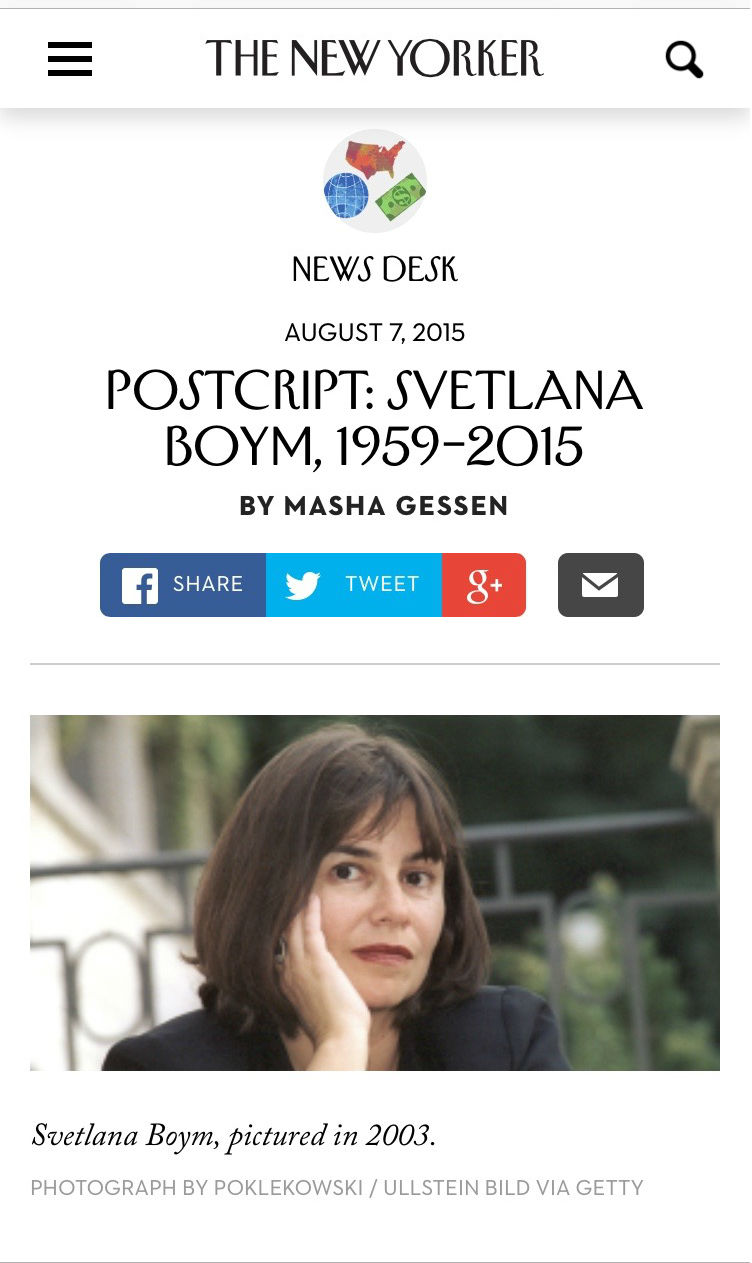The Aura of an Error
In a recent New Yorker obituary, Masha Gesson celebrates the kaleidoscopic life of her friend Svetlana Boym, a woman of letters and of photographs. She was also my professor. I walked into her class by accident and I stayed.
The New Yorker begins all of its obituary headlines with the word “POSTSCRIPT.” The postscript is, we know, a piece of writing that appears after a letter’s sign-off and signature — “post-scriptum” in the orginal Latin, or “written after." It’s an extra bit of news, an aside. I wonder, when paper-and-ink was the thing, if the postscript wasn’t also a technological innovation of sorts: Without easy editing tools, you’d have to rewrite a letter from scratch if you forgot to mention something – much easier to just tack it on the end. The New Yorker is deploying their “POSTSCRIPT” a little differently, in witty deference to the lives of thinkers and writers whose last words, like Professor Boym's, have been written.
Professor Boym’s obituary, though, is different. It begins “POSTCRIPT” – the second “S” is missing. The word on the page, especially in The New Yorker’s distinctive typeface, has the quality of an optical illusion. It took several seconds of staring and a side-by-side comparison with another New Yorker obituary for me to confirm the misspelling. I took a screenshot.
Since I first learned of her death, I’ve checked daily to make sure that it hadn’t been fixed (as of September 21st, it hadn’t). It’s a thrilling typo, one with the charge of a secret: What wouldn’t have meant anything hovering above another name takes on special resonance over Svetlana Boym’s.
Professor Boym collected glitches like this, these moments of naturally occurring détournement. By linking such moments, and demonstrating their seemingly elective affinity, she illuminated an alternative history of the 20th century. She was able to demonstrate how, in Walter Benjamin’s words, “what has been comes together in a flash with the now to form a constellation.”
Professor Boym had the ability to conjure such Benjaminian flashes. I remember her telling us about the announcement of Lenin’s 1920 plan to bring electricity to all of Moscow and beyond. On the Bolshoy Theater stage, once host to ballet and opera, an electrified "map of the future" was carted out. Light bulbs indicated the locations of Lenin's soon-to-be-built power plants. As the event reached its climax, the great map’s light bulbs were triumphantly illuminated – and lights all over the city went dark. The map of the power plants used too much electrcity, and caused a power outage. In what was, in this case, a literal flash light, previously unlinked fragments of history came together to formed a new constellation of meaning: a glimpse of the Soviet Union's doomed future. Professor Boym was an archivist of moments like this. “I collect computer errors,” she wrote in her Off-Modern Manifesto, “An error has an aura.”
Beyond the satisfying irony of seeing an authoritarian grammar regime falter, it seems like there is some deeper meaning hidden within The New Yorker’s “POSTCRIPT” error. Missing its “S,” we are left with POST-CRIPT; the leap to “CRYPT” is short, considering the context. “CRYPT” connotes not only death, not only the tomb, but also secrecy and hiddenness, as in "encryption" and "cryptic." In Derrida’s gloss, “No crypt presents itself. The grounds [lieux] are so disposed as to disguise and to hide...But also to disguise the act of hiding and to hide the disguise: the crypt hides as it holds.”
Here the word "crypt" – secrecy itself – is hidden, encrypted, inside of The New Yorker’s error. The error is the secret, and the secret is the error – the revolutionary power of the mistake, of that which escapes determination. This was also Professor Boym’s secret: “The margin of error,” she writes, “is the margin of freedom.” The error is the territory that is left to be mapped, the still-dark site of art and revolution – the “space of humanity itself.”
I hope that The New Yorker lets the error stand. Though we have lost, far too soon, the preeminent archeologist of the error, I believe she would see the “CRIPT” as an entrance into her thought, as a digital monument to our “margin of freedom.” I hope she would be pleased.
Postscript
I shared a birthday with Professor Boym. In 2010, I wrote her to wish her a good day. I told her it seemed like all of us who share birthdays are in a secret club. “We are a non-Masonic lodge,” she replied.
A secret society, a society of the secret.
Download a PDF version of this article.

